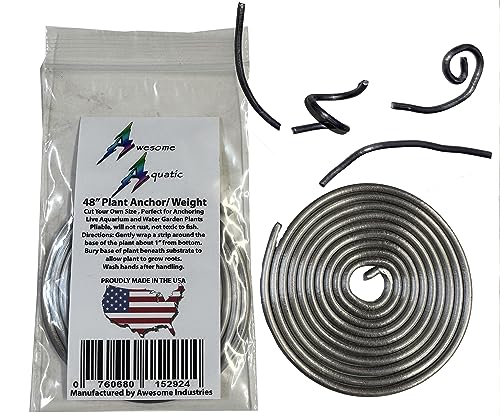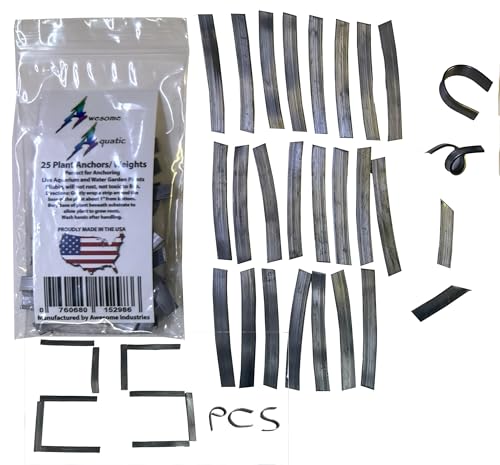Keeping live plants in your aquarium is one of the best things you can do.
Not only are they beautiful, but they also provide cover and hiding places for fish, eat up excess nutrients from fish waste and release oxygen into the water.
But sometimes, trying to add plants to your tank can be frustrating. A lot of species of aquarium plants are very buoyant and don’t want to stay put when you first plant them in your substrate.
Or maybe you’ve got the kind of plants that aren’t supposed to be put in the substrate at all, and you don’t know how to hold them in place.
It can seem like, every time you turn around, the plants are uprooted and floating at the top of the tank. It can drive you crazy at times.
Don’t give up on your dream of lush, gorgeous plants in your tank just because they stubbornly want to float. Today, I’ll go over some simple techniques I’ve used many times over the years to anchor plants in my aquariums.
How to Anchor Aquarium Plants
There are many different kinds of aquarium plants, so you’ll likely need to use more than one of these methods to get all your plants to stay put.
1. Bury Stem Plants
Materials: none
Kinds of Plants: stem plants, like anacharis or rotala
Method: I know that when I first started out with live plants, I thought I would just be able to stick the plant down in the gravel and it would stay.
If only it were that easy!!
Usually, when you buy stem plants, you get a bundle of stems with leaves on them, with little to no roots. Greenhouses just trim off the top half of the plants in their grow tanks, fasten them into bunches and ship them out.
The stems will grow roots…eventually. But you have to anchor them in the meantime.
You’ll need to bury more of the stem than you might realize at first, at least 3-4 inches (7.5-10 centimeters). This will bend the plant, but honestly, after years of doing this, I’ve never had it negatively affect any of my stem plants.
As time passes, the part of the stem that’s under the substrate will put out roots and anchor the plant.
It might seem a little extreme when you first plant the stems, but it will provide a substantial base for roots to grow out of.
2. Lead Plant Weights
Materials: lead plant weights
Kinds of Plants: stem or rhizome plants
Method: Lead plant weights are strips of pliable lead that can be bent around bunches of plants. It’s very easy to bend this stuff and you can easily cut it to the right length with ordinary scissors or kitchen shears.
Some people sometimes balk at the idea of using lead plant weights, worrying that using lead in the aquarium will be toxic.
I’ve personally used led plant weights for years now and seen no adverse effects whatsoever. And, these are the same kind of ties that pretty much the entire aquarium plant industry uses in all of their greenhouses.
You can get pre-cut pieces of lead or a roll so you can cut pieces to size.
The lead is very heavy for its size, so you only need just enough to wrap around the plants. Make sure not to wrap too tightly around delicate stems.
I’m fond of this method because it’s very quick, easy and effective. The only real pain is trying to hide the weights. You can bury the part of the stems that the weights are wrapped onto.
Over time, the buried portion of the plants will put out roots that will help them in place.
For rhizome plants, you can even put the weights behind rocks or other decor.
| Preview | Product | |
|---|---|---|

|
Plant Anchors/Weights 48" Strip Cut Your Own Size Lead Ribbon or Rod Live Plants Awesome Aquatic... | Buy on Amazon |

|
Plant Anchors/Weights 25 pk Strip Lead Ribbon Live Plants Awesome Aquatic Weight Anchor (25 Pack... | Buy on Amazon |
Last update on 2024-04-25 / Commissions Earned / Images from Amazon Product Advertising API
3. Rocks at the Base
Materials: river rocks
Kinds of Plants: rooted plants, like Amazon sword or Cryptocorynes, stem plants
Method: Sometimes, all that’s needed to keep plants from floating off is some extra weight around their roots.
I already really love to incorporate rocks and other forms of hardscape in my tanks, so this method easily fits in with my tanks.
Simply place the roots down in the substrate and then make a small pile of river rocks around the base of the plant.
You want to pile everything tightly around the plant’s stems. This extra weight and support can keep the plant still long enough for the roots to grow in and permanently anchor everything.

Last update on 2024-04-25 / Commissions Earned / Images from Amazon Product Advertising API
4. Super Glue
Materials: cyanoacrylate glue (Crazy Glue, Loctite, Gorilla Super Glue), rocks, driftwood or heavy decor
Kinds of Plants: rhizome plants, like anubias and Java fern, mosses, like Java or flame moss
Method: Securing rhizome plants and mosses to rocks or other decor with super glue is really, really simple.
Just make sure that you use glue that is pure cyanoacrylate.
You don’t have to worry about trying to get things dry. The glue will set just fine, even under water if need be.
All it takes is a small dot of glue on the surface of the rock or decor and then you just press the plant onto the glue and hold for about 30 seconds, that’s it.
With moss, I just try to press a gob of it onto the glue. Sometimes, you might need to add another dot or two, but it’s really forgiving. Usually, as long as you have a portion of the clump glued down, the rest will stay with it.
And don’t worry if the plant is kind of at a weird angle on the rock. Within a few days, the leaves will bend towards the light and the plant will right itself and look more natural.
I’ve used this method to secure many species of plants to a wide variety of rocks and decor. It works really well on driftwood and even resin decorations.
Over time, the plants and moss will start to adhere to the rock/decor by themselves. The roots of things like anubias and Java fern are sticky and will cling to the surface, forming a tight bond. And mosses put out these little sticky “feet” that will cling to the surface you’ve glued them to.
I would caution you to work very quickly. The glue sets in under 30 seconds, so you don’t have much time to reposition anything.
I love using this method because I can move the plants around the tank all I want. I just move the rock to a new place in the tank, any time I want since nothing is stuck down in the substrate.
There are a lot of brands of glue out there that you can use, I personally prefer Gorilla Micro Precise Super Glue. You can use river rocks like the ones that I linked earlier as weights.

Last update on 2024-04-25 / Commissions Earned / Images from Amazon Product Advertising API
Final Thoughts On Anchoring Plants
Adding live plants to your aquarium can be so rewarding and beautiful. Plants help keep your tank healthy by eating up excess nutrients, like nitrates and phosphates, that can build up as fish wastes break down.
But, it can sometimes be frustrating to get plants to stay put when you first place them in your tank.
Luckily, there are several ways to anchor aquarium plants to keep them from floating around on their own misadventures.
I highly recommend having a bag of river rocks handy. They’re great for placing around the bases of plants. You can also glue plants to them and they look great in the tank.
I hope you find this article helpful.
I wish you and your fish the very best!
